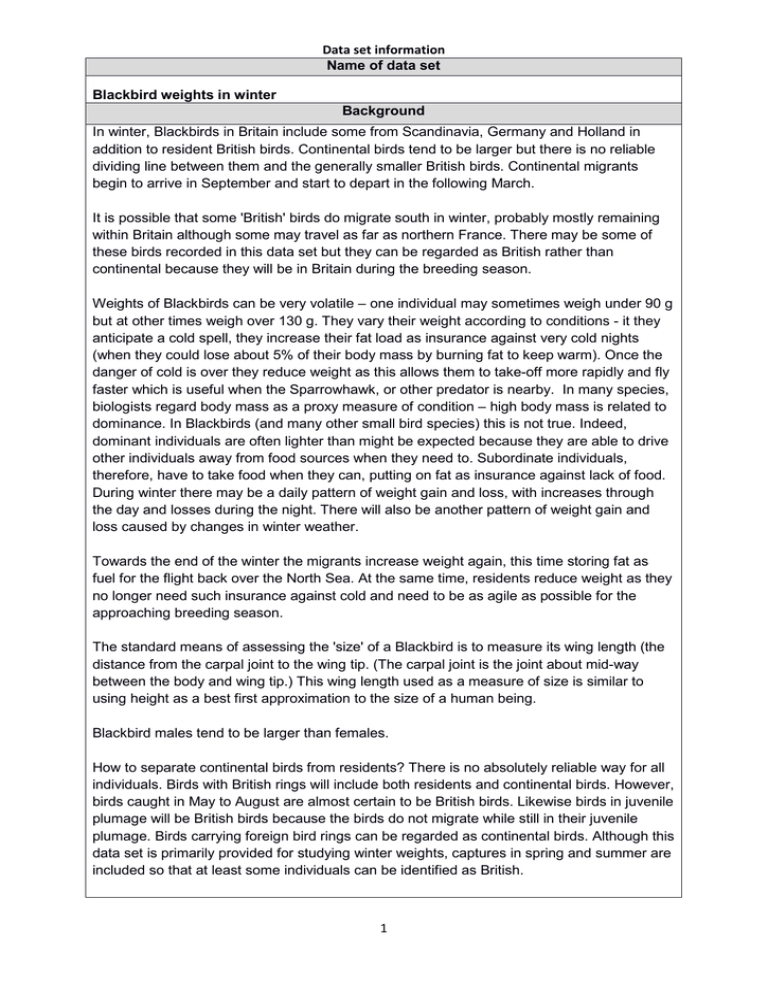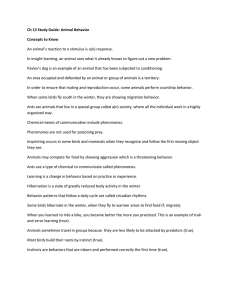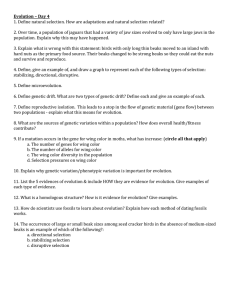Data set information Name of data set Blackbird weights in winter Background
advertisement

Data set information Name of data set Blackbird weights in winter Background In winter, Blackbirds in Britain include some from Scandinavia, Germany and Holland in addition to resident British birds. Continental birds tend to be larger but there is no reliable dividing line between them and the generally smaller British birds. Continental migrants begin to arrive in September and start to depart in the following March. It is possible that some 'British' birds do migrate south in winter, probably mostly remaining within Britain although some may travel as far as northern France. There may be some of these birds recorded in this data set but they can be regarded as British rather than continental because they will be in Britain during the breeding season. Weights of Blackbirds can be very volatile – one individual may sometimes weigh under 90 g but at other times weigh over 130 g. They vary their weight according to conditions - it they anticipate a cold spell, they increase their fat load as insurance against very cold nights (when they could lose about 5% of their body mass by burning fat to keep warm). Once the danger of cold is over they reduce weight as this allows them to take-off more rapidly and fly faster which is useful when the Sparrowhawk, or other predator is nearby. In many species, biologists regard body mass as a proxy measure of condition – high body mass is related to dominance. In Blackbirds (and many other small bird species) this is not true. Indeed, dominant individuals are often lighter than might be expected because they are able to drive other individuals away from food sources when they need to. Subordinate individuals, therefore, have to take food when they can, putting on fat as insurance against lack of food. During winter there may be a daily pattern of weight gain and loss, with increases through the day and losses during the night. There will also be another pattern of weight gain and loss caused by changes in winter weather. Towards the end of the winter the migrants increase weight again, this time storing fat as fuel for the flight back over the North Sea. At the same time, residents reduce weight as they no longer need such insurance against cold and need to be as agile as possible for the approaching breeding season. The standard means of assessing the 'size' of a Blackbird is to measure its wing length (the distance from the carpal joint to the wing tip. (The carpal joint is the joint about mid-way between the body and wing tip.) This wing length used as a measure of size is similar to using height as a best first approximation to the size of a human being. Blackbird males tend to be larger than females. How to separate continental birds from residents? There is no absolutely reliable way for all individuals. Birds with British rings will include both residents and continental birds. However, birds caught in May to August are almost certain to be British birds. Likewise birds in juvenile plumage will be British birds because the birds do not migrate while still in their juvenile plumage. Birds carrying foreign bird rings can be regarded as continental birds. Although this data set is primarily provided for studying winter weights, captures in spring and summer are included so that at least some individuals can be identified as British. 1 Data set information Characteristics of the data set These records have been collected in the same garden in the East Midlands over 25 years. A few birds, when first trapped in the garden, already have a ring. These include those with foreign rings and a few with British rings. Unringed birds are ringed on their first capture in the garden. The earliest capture in the garden of any individual (should that be relevant to any analysis) can be found by examination of dates of captures. Catching effort has not been the same from year to year. Some individual birds have been trapped repeatedly and some recapture information may need to be discarded for some analyses. Wing length is very difficult to measure without error and so recorded wing lengths on any individuals may be expected to vary by a millimetre or so about the mean. In addition, wing lengths on individuals gradually reduce from late summer to the next summer through abrasion, meaning a Blackbird wing of, say 120 mm in autumn may be only 118 mm before the moult in the following summer. Note that where feathers have clearly lost their tip through severe abrasion or, perhaps close encounter with a predator, the wing length will not be measured. Feathers on juveniles are also shorter than those on adults but, after the first full moult when the bird moves from First Year to Adult plumage, the wing length will be unlikely to increase further in subsequent moults. In addition to all these possible sources of variation, it is always possible that a wing length has been measured correctly but recorded inaccurately. Examples of errors include transposition of digits (so that 114 becomes 141) or misreading the position on the rule by 10 mm. In the summer moult, new feathers are grown which may be slightly longer than feathers the previous year. Birds which are moulting and with feathers not fully grown will not have the wing measured. Before doing any analysis using wing lengths it could be useful to look at individual birds which have been trapped more than once and remove any wing lengths which are clearly incorrect. It might also be useful to assign an average wing length to each individual which has been caught more than once in any age class. For any analysis which involves time of day, note that times in summer are BST so will need one hour subtracting to bring them into line with the winter GMT. Note that in some cases, either wing or weight may be missing, age or sex may also not be recorded. In some cases, age and sex can be established from other captures of the same bird. Clearly sex should be the same throughout the life of the bird, but age will change with time. All these various points can give considerable opportunities for practice in data preparation. 2 Field name Data set information Fields Description Scheme The ringing scheme Ring number Age Alphanumeric to identify individuals Three age classes are usually distinguishable although sometimes the class cannot be determined and is recorded as Unknown. Sex Sex can be determined for almost all individuals, others recorded as Unknown. Wing Weight Day Month Year Time Length from carpal joint to wing tip. Total weight Code(s) and units GBT are British rings; all others are continental. Nearest hour. Local time. J – Juvenile F - First year A – Adult U - Unknown M – Male F – Female U - Unknown Millimetres to nearest mm Grams to nearest 1 g Numeric 1-31 Numeric 1-12 Numeric, 4 digit Numeric Ideas for investigations Changes in wing length with age. Look for individuals which have been measured as Juveniles or First year and again in Adult plumage. How much longer are adult wings than Juvenile/First Year wings? Give summaries of the wing length statistics for the four age sex classes (male/female, adult/first year). Summaries could include either medians and quartiles or means and standard deviations with appropriate graphical summaries. By looking at average wing lengths throughout the year (perhaps using day number of the year to measure time of year or else using time in half-month intervals), suggest when the longer-winged continental birds arrive and depart. Birds caught as juveniles or any caught in May to August inclusive can be regarded as British resident birds. Thus resident birds can be identified if they have any capture in this time period. Birds caught at other times could be residents or continental migrants. By examining birds with captures in two or more successive summers is it possible to discover whether some British birds do leave the breeding area in winter and return the following breeding season and, if so, what proportion of birds carry out this local migration and what proportion remain at the breeding site during winter? (Note that not all birds in the sampling area will be caught each year so lack of a capture does not necessarily mean a lack of presence.) By examining the dates on which the same individuals were caught within one winter, is it possible to determine whether wintering Blackbirds tend to remain in the same area throughout the winter, wander at random or else pass through and area on the southward winter journey and return through during the return journey in late winter? For winter birds (November to February inclusive), standardise weight according to wing length time of day, date, age, sex and wing length. (This will require a general linear model analysis – GLM - and may include interactions between some variables. Note that GLM is beyond the scope of A level syllabuses but see the note.) Note that times are local – GMT in winter and BST in summer. Including 'length of day' as an additional factor could also be very interesting – various web sites give 'length of day' calculators. 3 Data set information Further research Past weather data may be available from some web sites. Because Blackbirds respond rapidly to cold weather in winter, changes in weight could be examined in relation to winter weather. It is commonly supposed that Blackbirds increase weight in anticipation of a 'cold snap', perhaps two or three days in advance, and increase fat stores (and thus body weight) to prepare for it. Weights reduce again once the cold ends. Cold spells may cover the whole country or may be fairly local. The Blackbird data are gathered in the East Midlands so examination of weather data from this area is more likely to be productive. Wind direction and speed will influence the times of arrival and departure of winter migrants – migration will be delayed if winds are opposite in direction to the migration route. Can any connection be found between times of arrival/departure and wind speed/direction over the North Sea? General Linear Model - GLM The GLM concept is essentially very simple, although the difficulty of the theory and calculations involved put it beyond the A level syllabuses. At its most elementary, it is a technique for giving a formula for a dependent variable in terms of the several independent variables. That is a concept which is very easy to grasp. GLM analyses are available in statistical packages, such as Minitab. 4





